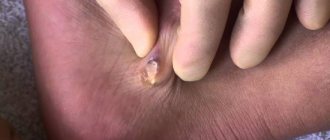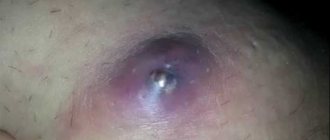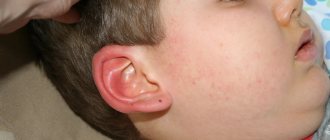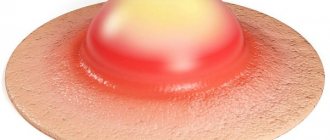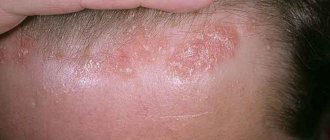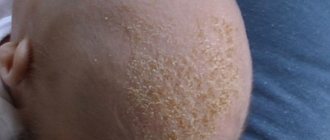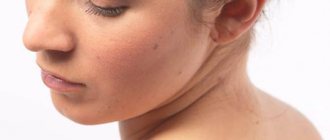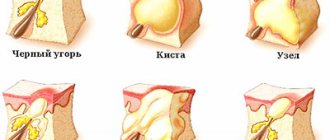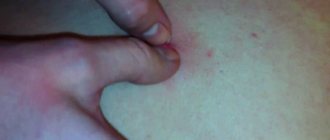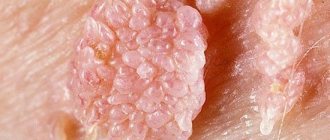A boil on the head in the hair is a fairly common occurrence. It is on this part of the head that there are many hair follicles, and any of them can become inflamed. You can discover a small boil by accident when scratching your head. If the inflammatory process is severe, then discomfort will be felt immediately in the first stages of the formation of an abscess. The causes and treatment of furunculosis on the head are closely interrelated. Some patients are recommended general restorative therapy, others – applications with antibacterial drugs. Treatment tactics are determined by the doctor after examining the pathological area and clarifying concomitant chronic diseases.
Causes of boils
The cause of boils is infection of the hair follicle with Staphylococcus aureus bacteria (most often) or other pathogenic microorganisms. An infection can get into the hair root when scratching the head with dirty hands. Any cracks, scratches, or burned surface are suitable conditions for the penetration of pathogenic flora into the dermis.
A boil appears on the head suddenly, without previous general symptoms. According to statistics, there is a surge in furunculosis in the head and neck area in the autumn and spring periods. This seasonality is explained by provoking external conditions - drafts, wind, increased humidity - and a decrease in one’s own defenses due to hypovitaminosis and deterioration of immunity.
After infection of the hair follicle on the head, an inflammatory reaction begins in nearby tissues. In place of the hair, a purulent rod forms. This process is caused by a defense response when macrophages are released to fight infection. Dead leukocytes and bacteria form purulent masses. With significant suppuration of the boil, tissue at the site of inflammation may partially die. This process is called necrosis.
What to avoid
Since there are many ways for a boil to appear on the head, and in order to properly treat the problem, you need to be able to accurately determine the factor that contributed to its development. To find exactly that unpleasant moment that turned out to be favorable for the appearance of a boil on the head, a person needs to perform the following analysis:
- check the condition of the bathroom in your own home;
- carefully study the composition of products that are used for head hygiene, see if they are suitable for a specific skin type, and whether the expiration date has passed;
- undergo a full examination in the hospital to find out if there are any health problems;
- analyze the quality of food, monitor your own daily routine;
- identify bad habits and eliminate them;
- determine whether the body has enough vitamins and other nutrients;
- examine the scalp and see if there are any wounds or scratches there;
- If towels or other similar items are old, replace them with new ones.
If a boil on the head occurs due to significant health problems, it is worth addressing them, and when the cause of the boil is a human factor, the victim should be more attentive. You need to carefully monitor the cleanliness of your own home, correctly perform hygiene procedures, using the most suitable means for this, and then almost all causes of boils will be eliminated.
dermatolog03.ru
Signs
The first symptoms of a boil on the head in the hair are the appearance of local hyperemia and thickening.
In the case when a carbuncle develops, that is, inflammation of several nearby hair follicles occurs, the patient feels severe pain when palpating the affected area on the head. A single small boil, as a rule, almost does not provoke pain symptoms; discomfort is felt more.
With your fingers you can feel a small bump or infiltrate in the layers of the skin. If you examine the pathological area on the head in the mirror, redness will be visible.
Boils on the head quickly fester, and white or yellow contents begin to be visible in the center of the hyperemic area under the skin. The tissues of the head are better supplied with blood, and the scalp is no exception. Therefore, the process of formation of a purulent-necrotic core proceeds faster than in other parts of the body.
If extensive ulcers occur on the head, the following may appear:
- chills;
- significant increase in body temperature;
- general weakness up to loss of consciousness.
These are signs of the spread of infection, which leads to serious consequences.
Symptoms
It can be difficult to detect an inflammatory process on the back of the head. The initial sign will be discomfort when touched on any part of the skin.
The patient can feel a slight swelling on his own.
Externally, a boil on the scalp has the following symptoms:
- there is a small swelling between the hairs, which is painful during palpation;
- the skin in this area is enlarged and feels hot to the touch;
- in the middle there is a rod with purulent contents;
- when the abscess is opened, pus comes out of it;
- the hair in this area falls out, the roots can become covered with a purulent crust;
- the inflammatory process is associated with itching;
- The inflammation ends with the formation of a crust, which will fall off after 4-5 days and leave a slight scar.
Some patients experience general symptoms such as weakness and chills. Symptoms will become more pronounced during multiple furunculosis. This condition is characterized by the appearance of 2 or more ulcers in different parts of the head at once.
Without proper therapy, the abscess can increase in size, in which case a carbuncle will form. It represents a broader pathological process that does not disappear on its own.
The diagnosis is made based on typical symptoms. Inflammation in the blood is extremely insignificant or absent altogether.
From this we can conclude that if a lump appears on the surface of the head, you must immediately contact a specialist - regardless of the appearance of the growth. Even if the neoplasm is a simple lump, the doctor will recommend eliminating the pathology as soon as possible in order to avoid any consequences.
Why is pathology dangerous?
Any purulent-inflammatory process can lead to the spread of infection throughout the body. Furunculosis on the head is more dangerous due to its close location to the brain. If the infection penetrates the blood-brain barrier, the sensitive membranes of the brain quickly become infected and meningitis and encephalitis are formed. With the development of these complications, the prognosis for the patient is unfavorable, even death.
A small boil on the head, if not aggravated, should quickly ripen, and after 4-5 days the tissue is completely regenerated, not even a trace remains at the site of the boil.
If the patient injures the affected area, the infection spreads to adjacent healthy tissue. Inflammation of the sebaceous glands begins, neighboring hair follicles become infected, and several abscesses form. This process will require long and careful treatment.
Another dangerous complication if proper treatment is not followed is sepsis, that is, blood poisoning. In a healthy person, the blood is sterile and does not contain any bacteria. With extensive infection or mechanical damage to the boil, pathogenic bacteria enter the interstitial fluid and then into the bloodstream. Blood has a bactericidal effect, but with a large number of bacteria and a decrease in immune functions, the infectious agent does not die, but is spread through the bloodstream throughout the body. Staphylococcus or other microbes begin to infect new areas of the body, take root on the mucous membrane of the intestines and other organs, provoking endless foci of inflammation. This serious complication requires urgent hospitalization. Treatment with loading doses of antibiotics cannot always stop sepsis; the prognosis for the patient is rarely favorable.
Preventive measures
Preventing the development of boils is easier than treating them. To do this, it is necessary to identify and treat diseases that provoke their occurrence, observe hygiene rules, harden yourself, protect the skin from damage, eat a balanced diet, and also get regular and proper rest.
A boil on the scalp (furuncle) is one of the common skin diseases, or rather, it is an acute inflammation of the hair follicle and surrounding tissue. As a rule, the reasons for its occurrence are quite varied, but the main one today is the effect of staphylococcus bacteria on the scalp. Infection with staphylococcus occurs through the hair follicle, passing through small lesions on the skin under the hair.
When a boil ripens, pus forms in its upper part, which should never be squeezed out, otherwise the infection will spread throughout the head. Infection may also enter the body. The result is the development of purulent meningitis or furunculosis. If you squeeze out a boil, you can get one or even several negative consequences. One of these can be called the development of a malignant boil. Such a boil can increase sharply, accompanied by large swelling. There is also a high density and tension of the skin in the area of formation. In this case, the person is worried about severe pain and fever. Other, no less dangerous complications that arise from such a phenomenon as a boil on the head include: 1. A cosmetic problem is expressed in the development of a purulent-necrotic cavity, which is the cause of hair loss. 2. Meningitis, encephalitis, thrombosis are a consequence of the presence of a boil near the brain. 3. When the infection moves to other areas, new boils may appear there. As a rule, this is the result of the chronic course of furunculosis on the head.
It is worth remembering once and for all the appearance of boils on the head - a dangerous purulent skin disease. Self-treatment, namely, puncturing and squeezing out pus, is strictly prohibited, as it can cause negative consequences.
Treatment methods
What to do when a boil appears on your head? Surgical, local drug treatment, and restorative therapy will be required. Treatment methods should be determined by a specialist after assessing the external condition of the boil, collecting anamnesis, and clarifying concomitant chronic diagnoses.
The choice of treatment method is influenced by:
- localization (the closer to the temple, the more dangerous);
- area of inflammation;
- the presence of necrotic lesions;
- general health of the patient;
- the presence of endocrine pathologies, especially aggravating the course of furunculosis, diabetes mellitus;
- the presence of other infectious diseases delays recovery (sore throat, acute respiratory infections, intestinal infections);
- pathologies of the immune system (HIV, secondary immunodeficiency).
Having specified all concomitant diseases and characteristics of the body, the doctor will prescribe general and local treatment. In case of severe, advanced suppuration or in the presence of complications, the doctor may resort to surgical intervention.
Conservative
An abscess on the head under the hair, if it has a small affected area, can be treated using conservative methods.
To quickly rid the patient of a boil on the scalp and prevent the spread of infection, the doctor prescribes vitamins and microelements. Complex multivitamins activate immune reactions and accelerate the process of tissue epithelization.
Local therapy consists of several stages:
- It is necessary to treat the surface of the boil and the skin around it. To do this, the hair is parted, the localization of the pathological process is wiped with a swab moistened with alcohol, furatsilin or another antiseptic.
- Lubricating the scalp where the boil is located with an antibacterial drug. This may be an ointment containing streptomycin, erythromycin, chloramphenicol, etc. Ichthyol ointment or Vishnevsky liniment is often used.
- After the boil has opened on its own, its surface is smeared with antiseptics, which have a drying effect. These include a 1% alcohol solution of brilliant green, a weak solution of salicylic acid.
- The use of healing ointments to accelerate regeneration. You can use Methyluracil, Solcoseryl.
To quickly rid the patient of a boil on the scalp and prevent the spread of infection, the doctor prescribes vitamins and microelements. Complex multivitamins activate immune reactions and accelerate the process of tissue epithelization. Tablets and powders based on brewer's yeast are often used to combat boils.
Operational
If the boil on the head continues to fester for more than five days, the doctor suspects complications, then surgical intervention will be required. Incision of the skin slightly below the center of the chirp will allow the purulent exudate to be quickly eliminated.
After promptly opening the abscess, the wound is washed with antiseptic solutions, then antibacterial ointments are applied, which will lead to the destruction of pathogenic microorganisms. The faster the inflammatory pathogens die, the sooner the healing process will begin.
In severe advanced cases of diffuse furunculosis, when pus spreads towards the brain, more serious surgery is required. The surgeon cleans the damaged surface as much as possible and leaves drainage for the outflow of pus. At the same time, he prescribes tableted antibiotics in large quantities.
Traditional medicine recipes
Treatment at home can be carried out for small, local processes when the root of one hair on the head is inflamed.
Boils on the head are treated with natural antiseptics: onions, garlic. Mumiyo quickly heals and kills bacteria. It is applied to the center of the boil and secured on top with a gauze cloth. If this procedure is done at night, then by morning the inflammation will be significantly reduced.
What to avoid
Boils develop in people at any age. The appearance of the neoplasm is preceded by infection of the hair follicle with Staphylococcus aureus. The infection provokes inflammation and suppuration of local tissues. Contents DescriptionCausesPollution of the skinSkin pathologiesUse of household chemicalsRare…
Since there are many ways for a boil to appear on the head, and in order to properly treat the problem, you need to be able to accurately determine the factor that contributed to its development. To find exactly that unpleasant moment that turned out to be favorable for the appearance of a boil on the head, a person needs to perform the following analysis:
- check the condition of the bathroom in your own home;
- carefully study the composition of products that are used for head hygiene, see if they are suitable for a specific skin type, and whether the expiration date has passed;
- undergo a full examination in the hospital to find out if there are any health problems;
- analyze the quality of food, monitor your own daily routine;
- identify bad habits and eliminate them;
- determine whether the body has enough vitamins and other nutrients;
- examine the scalp and see if there are any wounds or scratches there;
- If towels or other similar items are old, replace them with new ones.
If a boil on the head occurs due to significant health problems, it is worth addressing them, and when the cause of the boil is a human factor, the victim should be more attentive. You need to carefully monitor the cleanliness of your own home, correctly perform hygiene procedures, using the most suitable means for this, and then almost all causes of boils will be eliminated.
In order to eliminate boils, they often use improvised means to treat minor abrasions, for example, generously cover the problem area with brilliant green or iodine. When it turns out that this is not an ordinary pimple, but a boil, it becomes necessary to visit a surgeon. Then it is more difficult for the doctor to determine the true size of the lump.
If a ripening boil has burst, under no circumstances should you take a bath or shower, or make wet compresses. With an open purulent wound, any contact with water is prohibited due to the risk of loosening the abscess and spreading the infection.
Another common mistake is squeezing out boils with sharp objects (pin, needle, tweezers). Doctors, in principle, do not recommend doing this, and even more so it can be disastrous due to the risk of additional infection if the boil is located on the face. Regardless of the location, it is dangerous to remove the carbuncle yourself.
If the boil has opened, clean your hands with an antiseptic, carefully remove the leaked pus with a sterile gauze swab, cover the wound with a sterile bandage, then secure it well, but without pressure, with a bandage. This is necessary to protect the wound from additional infection before seeing the surgeon.
Features of child treatment
In children, boils appear on the head under the hair quite often due to poor hygiene and hypothermia. Small ulcers on the head are not dangerous; they go away with minimal treatment. However, the child needs to be explained that he should not touch the inflamed area. If boils appear in several places on the scalp, you should immediately consult a specialist for treatment.
A feature of the course of furunculosis in children is frequent relapses. The children's immune system is not able to maintain the production of protective immunoglobulins for a long time. When pathogenic microbes enter the skin layers again, the skin’s own defense does not work and inflammation develops again. Another feature is that children's skin is thin and easily vulnerable.
Hemangioma
The tumor is reddish in color. Appears in newborns. It should be treated only under the supervision of a doctor, since if it is damaged, various complications can arise.
This is the name of a lump that is formed as a result of a congenital anomaly of vascular development. Some types of this vascular tumor resemble a red growth. There are cases when through the tubercle on the head you can see the same irregular interweaving of blood vessels.
This type of disease poses a significant threat to human health, since the tumor can grow rapidly and become malignant. It can appear on such areas of the head as the forehead, ears, cheeks. Such a bump on the head can appear in representatives of both sexes and at any age.
This is a fairly large bump on the head, which occurs due to out-of-control vein growth. This formation is red in color, and the skin underneath is dotted with small vessels. It should be especially noted that this is the most dangerous type of all buds. After all, hemangioma leads to the destruction of all nearby tissues.
What not to do
In order not to provoke aggravation of the process, you should not perform manipulations that lead to the spread of infection and inflammation.
In case of furunculosis on the scalp, it is prohibited:
- squeeze out the abscess yourself;
- comb the affected area;
- make lotions, compresses;
- cut hair at the root around the boil;
- walk without a hat appropriate to the season and weather.
When the abscess is forcibly squeezed out, the inflammation spreads to the adjacent healthy tissue, and microbes begin to multiply there. This leads to the development of complications.
Traditional and alternative therapy
Before treating a boil on the head, it is necessary to undergo tests; KLA, OAM and bacterial culture to identify the pathogen and sensitivity to antibiotics. For recurrent furunculosis, the whole body is examined and the immune system is diagnosed. And only after receiving all the results, the doctor will know how to treat each specific patient.
To provide access to the boil, the surrounding hair is cut off. For local treatment, antiseptics are used, for example brilliant green, iodine, and “talk”, used in hospitals. Ointments are applied to the ulcers - Levomikol and Ichthyol ointment to improve the discharge of pus, and Erythromycin ointment as an antibacterial and antiseptic agent. Stop the inflammatory process of the bandage with the application of Salicylic acid or Trypsin.
What other external agents are used:
- Methylene blue.
- Octenisept.
- Fukortsin.
- Manganese solution.
- Baneocin.
- Fusiderm.
To speed up the maturation of the boil, physiotherapeutic procedures are carried out - ultraviolet, quartz, infrared irradiation or electrophoresis. If the abscess does not open for a long time, then they resort to opening it.
Antibiotics are needed to combat Staphylococcus aureus. Doctors try not to prescribe them for skin rashes, but if there are many ulcers or they occur in infants, then antibacterial therapy is a necessity. The most effective remedies for furunculosis are drugs from the group of macrolides and cephalosporins.
Boils that appear on the scalp can be cured using alternative medicine. But it should be remembered that such treatment is only possible for single formations.
Effective means:
- Grind fresh plantain leaves and mix with peach oil. Apply every day for 2-3 hours, securing with a bandage.
- Mix honey with rye flour to form a very thick mass. Apply at night every day.
- At the initial stage, a piece of garlic applied to the boil overnight will help.
- Cut the aloe leaf and apply the fleshy part to the abscess. Change every 3-4 hours.
- Melt a spoonful of pine resin and butter, add a spoonful of aloe pulp and lubricate the abscess twice a day.
There are spices that boost immunity and help the body cope with staphylococcus: cloves, parsnips, turmeric, mustard, ginger, cumin and red pepper. They suppress the growth of bacteria, so it is recommended to eat them daily for furunculosis.
What measures can stop the further appearance of boils?
To avoid relapses of furunculosis, it is necessary to strengthen the immune system. Hardening, taking vitamins, and proper nutrition with sufficient intake of proteins and microelements helps develop resistance to skin infections.
Autohemotherapy helps increase resistance to infections to which the body is susceptible. The principle of treatment is that several cubes of blood are taken from a vein and immediately injected intramuscularly.
If you follow hygiene standards, maintain the elasticity of the skin, eat only healthy foods, and do not overcool, then the risk of boils appearing is minimal.
What is seborrhea
A boil in the head area is the most dangerous pathological process on the skin. It appears due to inflammation inside the hair follicle and nearby tissue.
The term “seborrhea” translated from Latin literally means “seborrhea”, that is, excessive secretion of sebum. This disorder is associated with a change in the secretory function of the sebaceous glands and the chemical composition of the secretion they produce.
Disruption of the sebaceous glands, leading to the development of seborrhea of the scalp, is a pathological condition, most often caused by hormonal imbalance. When the secretion of sebum is impaired, the bactericidal properties of the sebaceous secretion are suppressed.
Additional diagnostics
Usually the diagnosis of a boil is not in doubt. It is determined by the doctor based on examination and medical history. If the patient develops multiple ulcers on the head that are difficult to treat or recur after treatment, then additional studies may be needed:
- General blood analysis.
- Immunogram.
- Analysis of purulent discharge (microscopy, culture, sensitivity to antibiotics).
Based on the results of diagnostic tests, it is possible to establish the cause of purulent inflammation and the factors contributing to its development. This makes it possible to conduct targeted therapy.
Sores on the head
Of course not. Effectively combating symptoms means eliminating their source : below we will talk about the most common skin diseases, their treatment and hair care methods.
On the contrary, cinnamon is perfect for lightening hair - here's everything about this alternative coloring method to ammonia dyes.
“A revolutionary remedy for combating dandruff, flaking and oily skin” - this is how most brands position their hair care products. Is it possible to solve all problems by lightly pressing the lotion spray?
Prevention measures
You can avoid furunculosis if you follow a few simple rules:
Nutrition should be of high quality, balanced, rich in vitamins.
- It is recommended to take additional vitamin complexes, especially during periods of decreased immunity.
- Hardening the body in reasonable measures is encouraged.
- Personal hygiene should be regular, using high-quality cosmetics.
- It is strictly forbidden to use other people's hygiene items.
- Any lump on the head should be promptly examined by an experienced specialist.
Boils are not as harmless a phenomenon as it might seem at first glance. For this reason, medical care should never be neglected . Especially if the foci of boils are multiple.
Top
